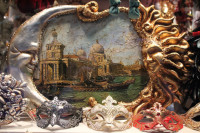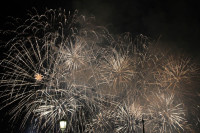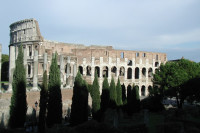In the name of God - the world of cathedrals
The Basilica of St Peter in Rome (Italy): world largest Christian interior sacred site
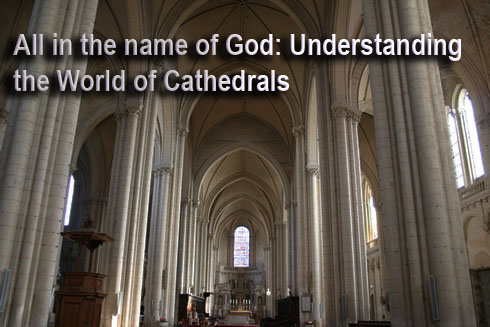
The Basilica of St. Peter in the Vatican (Italy)
World largest Christian interior sacred site
I love Rome and admiring the Michelangelo dome from the River Tiber is always a precious moment.
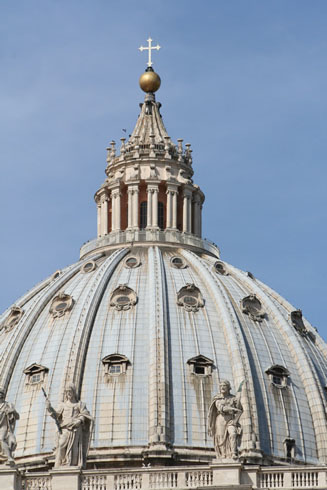
Basilica of St. Peter by night, Vatican
The interior of the basilica is also breathtakingly decorated with sculptures, mosaics, paintings, marble floors from the best artists in history.
Called Basilica di San Pietro in Vaticano, it is a Roman Catholic basilica, built to honor Mary, the mother of God.
It is one of the pilgrim holy stops in Rome. Others are: Santa Maria Maggiore, San Paolo Basilica, San Giovanni in Laterano Basilica, San Lorenzo outside walls, San Sebastiano and Santa Croce in Gerusalemme. It is the second most important out of the five basilicas in Rome.
Many think it is a cathedral but the bishop does not sit there, so it can’t be. It is the place where the pope holds most of his masses, even if the pope’s main basilica is San Giovanni in Laterano. San Pietrro is known as the Papal Basilica.
Saint Peter:
An apostle of Jesus founded a Christian church and was also the first bishop of Rome. Peter came to Rome and was martyrized in 64 AD. He was buried under the altar in St. Peter. The remains of the tomb were discovered 60 years ago this year, in December 1950 during the pontificate of Pope Pius XII.
Dimensions:
Height to the cross: 454 feet (138 m)
Height of of the dome: 448.1 feet (136.57 m)
It is the largest Christian interior church in the world: 227,070 feet (21,095 m2) and can hold 60,000 people.
Vatican cupola: diameter of 42,3 meters – just behind the Pantheon in Rome.
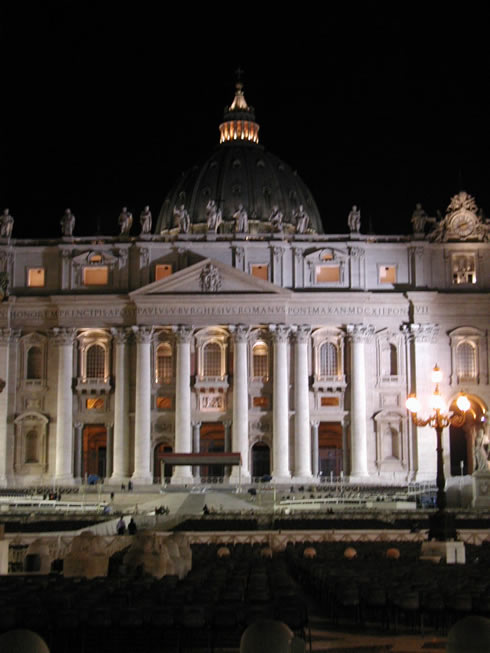
St. Peter’s dome, Vatican
Built: on Piazza San Pietro, Vatican from April 1506 – November 1626
It is Pope Urban VIII who overlooked its completion.
Last celebration of the Jubilee: celebrated its 26th Holy Year Jubilee in 2000 with John Paul II
Today’s Pope: since 2005, it is Benedict XVI
Crowned in St Peter’s Basilica: Emperor Charlemagne in Dec. 800 A.D.
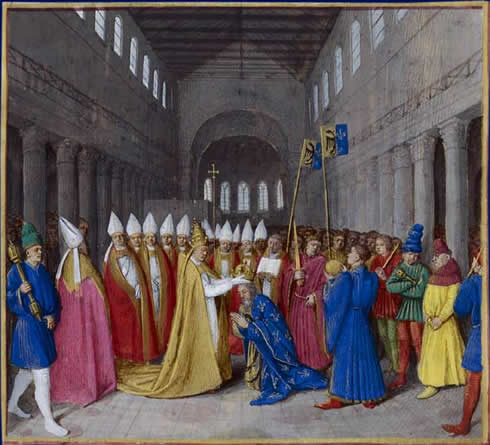
Crowning of Charlemagne in Dec. 800-Grandes Chroniques de France
Important dates and peoples in the history of San Pietro’s Basilica:
Most well known artists such as Bramante, Michelangelo, Boticelli, Raphael, Bernini and Vico Consorti worked in the Basilica
Started with Emperor Constantine in 324 AD on the spot of the Nero Circus, there were changes done during Pope Nikolas V (1447-1455) under the architect, Bernardo Rossellino.
A new Basilica was built by Pope Julius II. The old Basilica of St. Peter was in bad shape. Planning started and Bramante won the competition. Plans evolved due the different architects but at the beginning it was going to look like a Greek Cross. There were for instance changes to the nave, piers and bays.
Wooden models, engravings and drawings are still in Florence at the museum of Uffizi Gallery.
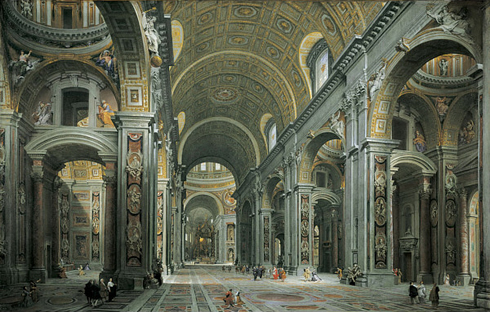
Painting from Giovanni Paolo Pannini 1731
- Donato Bramante: worked in St. Peter from 1506 to 1514. Had been inspired by the Pantheon’s dome.
- Raffaello: worked from 1515 to 1520
- Antonio da Sangallo the Youger: redesigned the building plans
- Michelangelo: known for the dome 1547-1564. He arrived at Pope Paul III’s demand. He only accepted the position to please the pope as he was already old. He went back to the old plans of Bramante with the Greek cross. He only finished the drum and never wanted to be paid for his work. He is also known for the beautiful frescoes in the Sistine chapel.
- Giacomo della Porta and Domenico Fontana: both finished the dome. Fontana worked on the lantern. Porta is also known to have worked on the vaults.
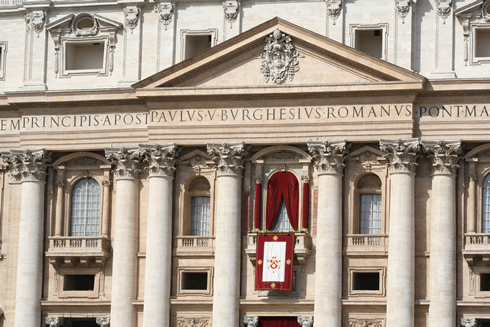
Outside Facade of St. Peter’s Basilica during Easter mass
- Carlo Maderno (nephew of D. Fontana): 1602 is responsible for the entrance, facade and nave. The facade was done quickly due to the pope’s impatience and it could have been done better. Maderno added three additional bays to Michelangelo’s plans. He is responsible as well for a fountain outside.
- Gianlorenzo Bernini: a genius architect and sculptor of the Baroque period – came under Pope Urban VIII and fullfil led his childhood’s dream of working on the throne.
- Giuseppe Cesar (Cavalier Arpino): decorated parts of the dome for Pope Clement VIII
- Vico Consorti: sculptor who built the bronze Holy Door in 1950
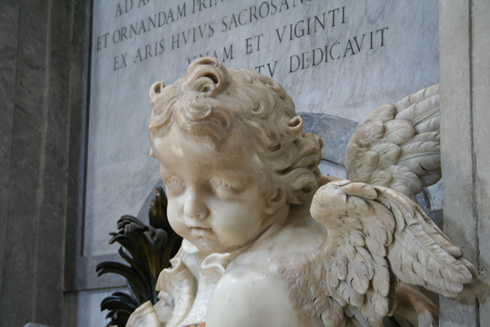
sculpted angel in St. Peter’s basilica
What to see:
- Pieta from Michelangelo located in the first chapel in the north aisle
- Frescoes by Raffaelo and Boticelli
- Altar, throne of St. Peter called Cathedra Petri by Bernini: located in the chapel of sacrament – throne is in gilded bronze, made as the the old St Peter’s chair was in bad shape. (1666)
- Baldachin also called canopy by Bernini: is a drapery made of bronze, on top of the altar.
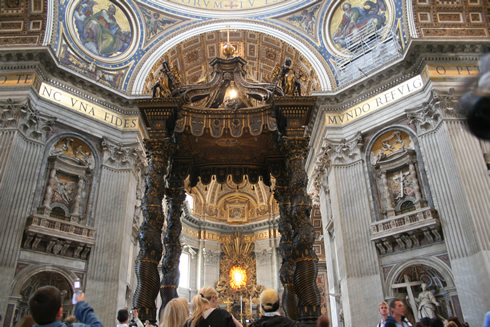
Altar and baldachin inside of St. Peter’s basilica
- Bernini towers and piazza with a fountain in 1675
- Portico in the entrance by Maderno
- Ovoid shape dome by Michelangelo and other architects
- Vatican grottoes-crypt: remains of old basilica, mosaics. The sacristy is full of history and treasures (most from the last 200 years) like crosses, religious clothing and jewels. You can see more than 100 tombs of popes, kings, important people.
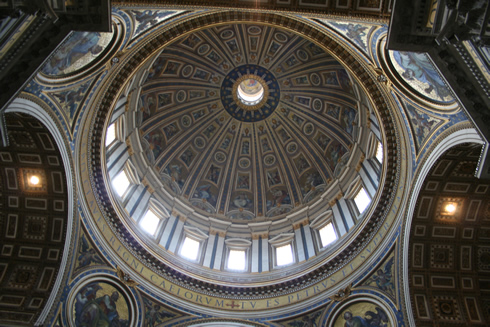
Michelangelo’s dome, St. Peter’s basilica in Rome
St. Peter’s square:
The square is known as Piazza San Pietro. It is spectacular with dimensions of 1,115 feet long (340 m) to 787 feet wide (240 m).
Designed by Bernini in two parts, one part is in a shape of a trapezoid and the other part is an ellipse, making the basilica appears closer than it is.
It has a colonnade with 248 Corinthian columns, 140 statues and 88 pilasters.
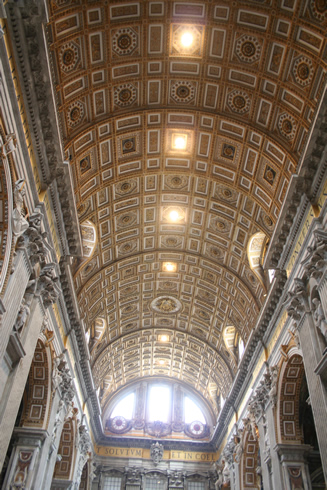
Ceiling in the central nave, St. Peter’s basilica Vatican
Climb the cupola:
Daily from 8:00 a.m. If you don’t want to climb 320 steps, take the lift for 7 euros. Stairs cost 6 euros.
Visit St. Peter’s basilica:
Daily from 7:00 a.m. to 7:00 p.m. from April through September and up to 6:00 p.m. from October through March

